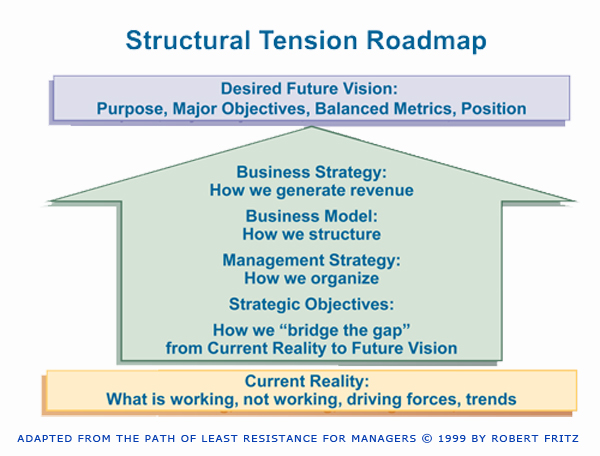Business Strategy Reflects Purpose and Reality
Business Strategy may have some complexity – but Business Strategy language need not be confusing. We present herein our Business Strategy definitions. You may use these terms differently or use entirely different language – but we suggest adopting a Business Strategy language and applying it consistently.
The Purpose or Mission guides business strategy. Purpose is the organization’s value, contribution or reason for being. Purpose is not defined by ROI or shareholder value. It instead defines the customer value that helps a business strategy produce financial results. The Purpose is enduring, broad and simply stated. It is not a destination but a guidance system for business strategy. Like a magnetic force it pulls the organization to reach higher. An example of a Purpose or Mission statement that clearly guides business strategy is that of Google: “To organize the world’s information and make it universally accessible and useful.
The Current Reality is our Business Strategy current position or starting point. The Current Reality summarizes what is working, not working, key forces, driving trends. Effective Business Strategy is anchored in the truth embodied in a realistic Current Reality baseline statement.

Business Strategy Delivers a Future Vision
A Future Vision is a bold aspiration that is consistent with the Purpose or Mission. Where Purpose is a guidance system, Vision is a business strategy destination. A shared Vision should empower, unify, and galvanize action toward the end targeted by the Business Strategy. Visions generally persist 1 to 5 years. A Business Strategy endures no longer than the Vision it supports. A Mission can be forever. The Mission of freedom embodied in Lincoln’s Gettysburg Address has endured long after his Vision – the preservation of the Union – was achieved.
The Business Strategy itself is a flexible plan to move from our Current Reality to our desired Future Vision. It defines how we make money as a company. A Business Strategy has three key dimensions – the desired end or objective, a course of action and the resources to pursue the objective. Tactics are more narrowly focused actions in pursuit of an immediate objective. In The Influence of Sea Power upon History, 1660-1783 (1890) Alfred Thayer Mahan suggested that Tactics involve direct engagement and that Strategy is the planning that precedes engagement (in our case, engagement with the market as opposed to the enemy). Tactical decisions are made to achieve immediate value. Strategic decisions are made to achieve broader overall value
- There are multiple elements and levels of Business Strategy
- Business Strategy: How we generate revenue
- Business Strategy Model: How we structure
- Management Strategy: How we organize
- Business Strategy Objectives: How we “bridge ” from our Current Reality to our Future Vision
An Objective or Goal is the desired end of a business strategy or of the vision that the business strategy supports. Goal is sometimes used as a synonym for Objective. Some also use Goal to describe a Vision. We use “goals” specifically to define financial objectives. Objectives and goals can be framed by “SMART” criteria – Specific, Measurable, Attainable, Relevant, Time-bound.
Organizational Values Are Business Strategy Standards
Values are the bedrock standards of the organization and of business strategy. They are concise set of beliefs that are deemed critically important. Values are changeless, timeless and never compromised. Core values are expressed in different ways by different companies – Microsoft’s “Our Values” Google’s “Ten Things We Know to be True” and Johnson& Johnson’s “Credo” all define values. Values should provide understandable, visible and practical guidance. Values underlie the Purpose, Vision, and Business Strategy and Objectives as well as the actions taken by every member of the organization.
